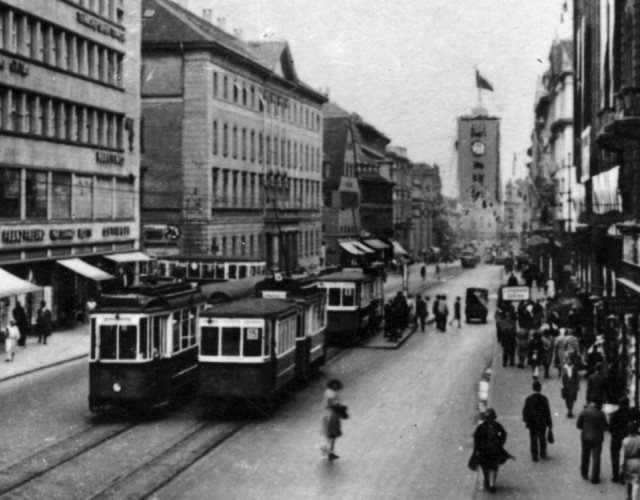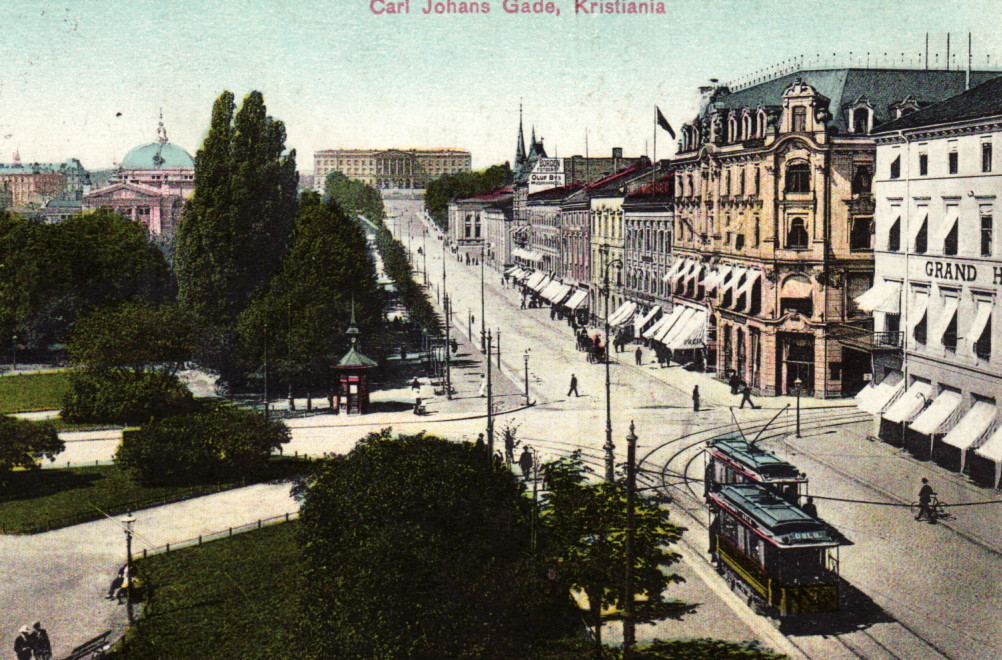you are in: photo > digest > historical views
Historical views: Trams on old postcards
view photos
(all photos below can also be enlarged by clicking)
History often comes to life through old photographs. Old postcards are an especially interesting category as they often focus on scenes of everyday life and (in most cases) are neither posed nor manipulated. Furthermore, they are readily available and often the photos are of exceptional quality. This page presents some of my recent acquisitions.
Most modern postcards present the special or spectacular, and often seek to emphasise the artistic abilities of the photographer rather than document real scenes. It reflects how values have changed in this respect, that old postcards often present the normal and mundane. I have rarely seen a modern postcard of Stauffacher for example (picture below). The scene is not on the tourist trail and for most visitors there is probably nothing special to see. The scene is important nevertheless for the many people who live there, work there or pass there every day on the tram.
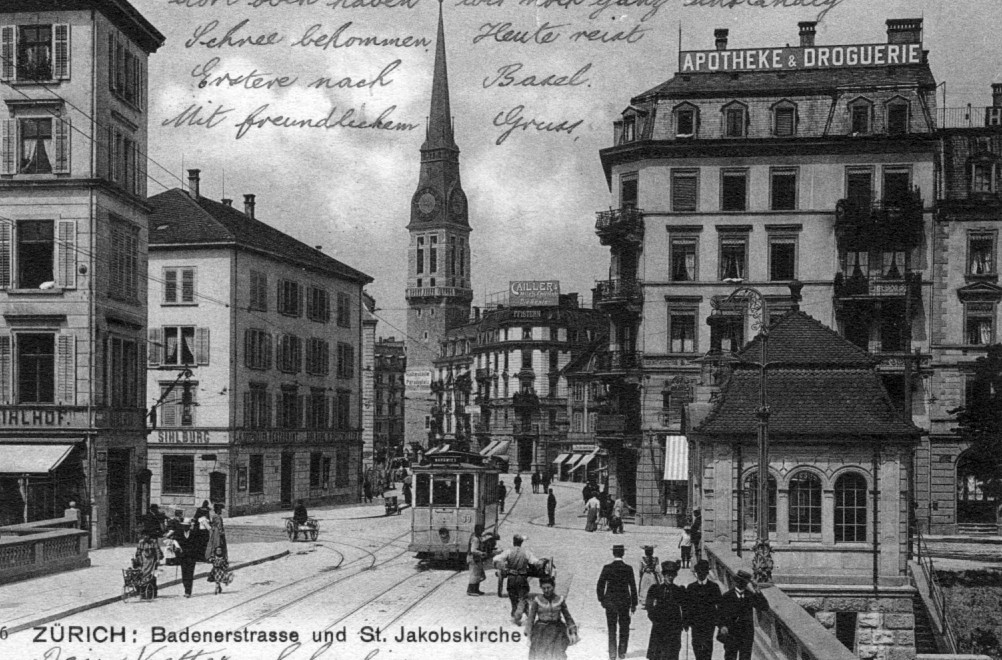 This view of Stauffacher is postmarked 1908. In the foreround is Sihlbrücke, a bridge connecting the neighbourhood of Aussersihl (which the photographer is facing) to the town's financial district.
This view of Stauffacher is postmarked 1908. In the foreround is Sihlbrücke, a bridge connecting the neighbourhood of Aussersihl (which the photographer is facing) to the town's financial district.
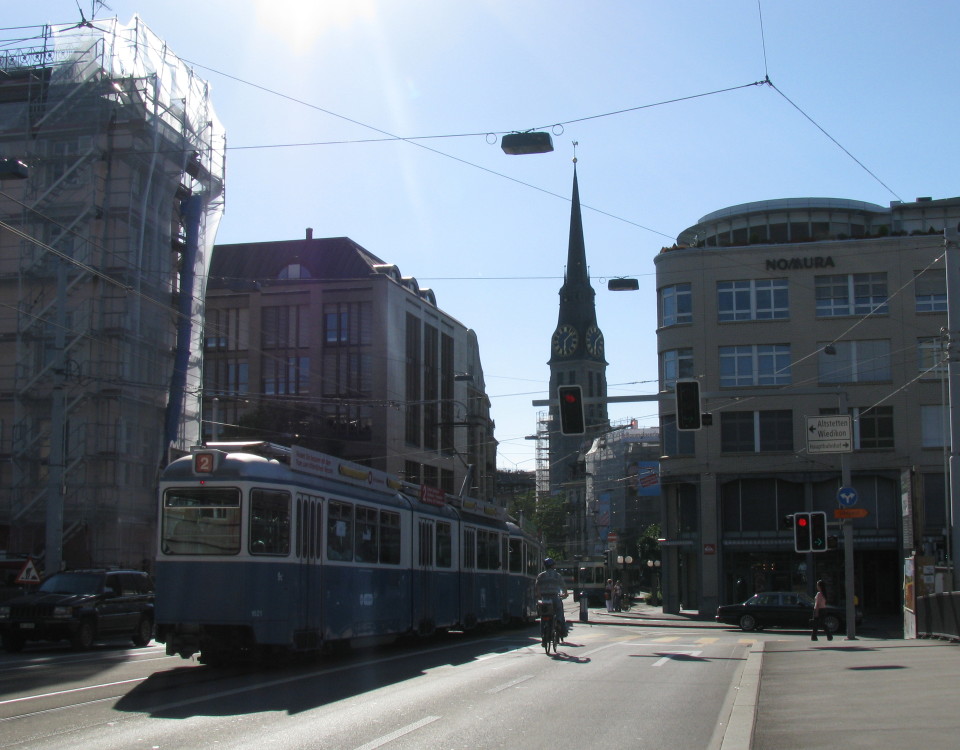 This is the same scene today. Although many of the buildings have changed, the location is still clearly recognisable, not least due to the spire of the St. Jakob church.
This is the same scene today. Although many of the buildings have changed, the location is still clearly recognisable, not least due to the spire of the St. Jakob church.
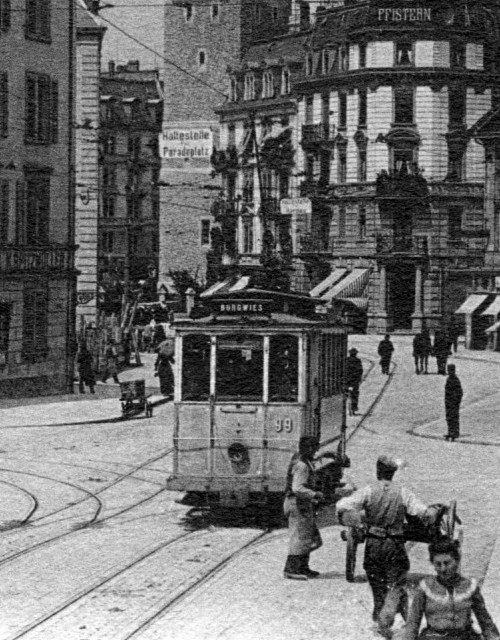 Let us take a close-up of the tram in the old picture. This is number 99, a sister vehicle of 102 that is today a museum tram. In the photograph it is still using a trolley pole. Also missing from today's museum car is the destination blind above the window. These proved too tricky to maintain and were later removed. This blind reads "Burgwies" (today's tram museum), but the tram is clearly headed in the wrong direction for that destination. Possibly the rear blind showed the origin and the front the destination? This would have relieved crews of changing them at the end of every journey. These trams were delivered in 1900 and lasted into the 1950s.
Let us take a close-up of the tram in the old picture. This is number 99, a sister vehicle of 102 that is today a museum tram. In the photograph it is still using a trolley pole. Also missing from today's museum car is the destination blind above the window. These proved too tricky to maintain and were later removed. This blind reads "Burgwies" (today's tram museum), but the tram is clearly headed in the wrong direction for that destination. Possibly the rear blind showed the origin and the front the destination? This would have relieved crews of changing them at the end of every journey. These trams were delivered in 1900 and lasted into the 1950s.
It is also of interest to see that tram tracks diverge to both the left and the right. Those to the right are still there today, carrying routes 3 and 14 to Hauptbahnhof. Those to the left were the original alignment of the Heuried line. The present alignment (in which the line branches off at the other end of Stauffacher, thus creating the present-day interchange) was established in 1914.
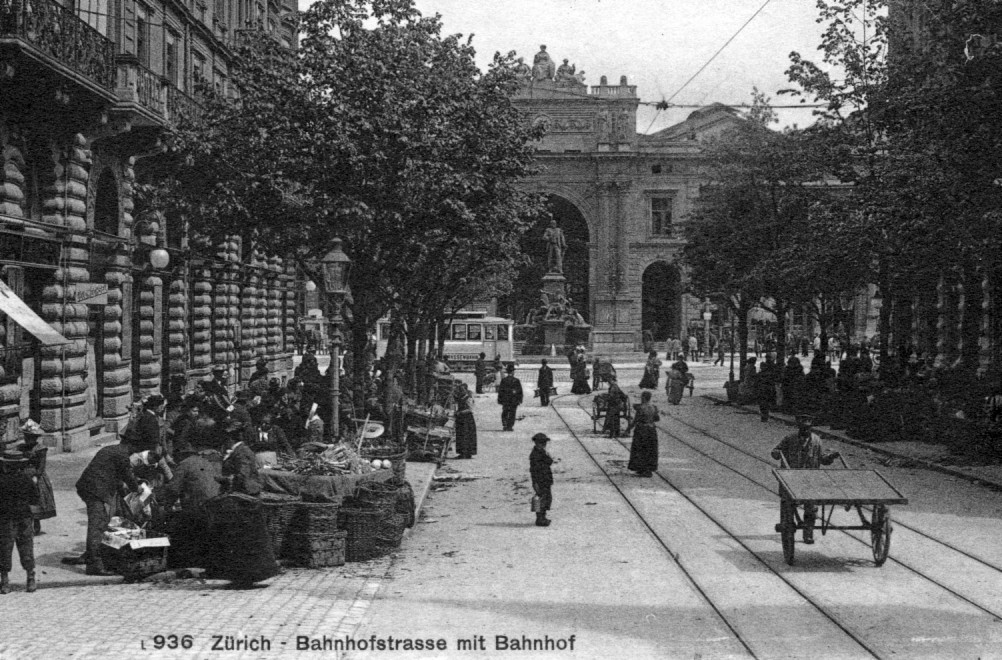 Our next destination is Bahnhofstrasse. This undated view, from the early years of the 20th Century, shows quite a different Bahnhofstrasse to that we know today, yet again it is a scene that is immediately recognisable. Zürich's Bahnhofstrasse is today one of the world's most prestigious shopping streets, although its star may be sinking somewhat with the likes of H&M now having stores there. However, today's Bahnhofstrasse is still a far cry from such rustical scenes as on this postcard. The tram rumbling past in the background is another sister of 102.
Our next destination is Bahnhofstrasse. This undated view, from the early years of the 20th Century, shows quite a different Bahnhofstrasse to that we know today, yet again it is a scene that is immediately recognisable. Zürich's Bahnhofstrasse is today one of the world's most prestigious shopping streets, although its star may be sinking somewhat with the likes of H&M now having stores there. However, today's Bahnhofstrasse is still a far cry from such rustical scenes as on this postcard. The tram rumbling past in the background is another sister of 102.
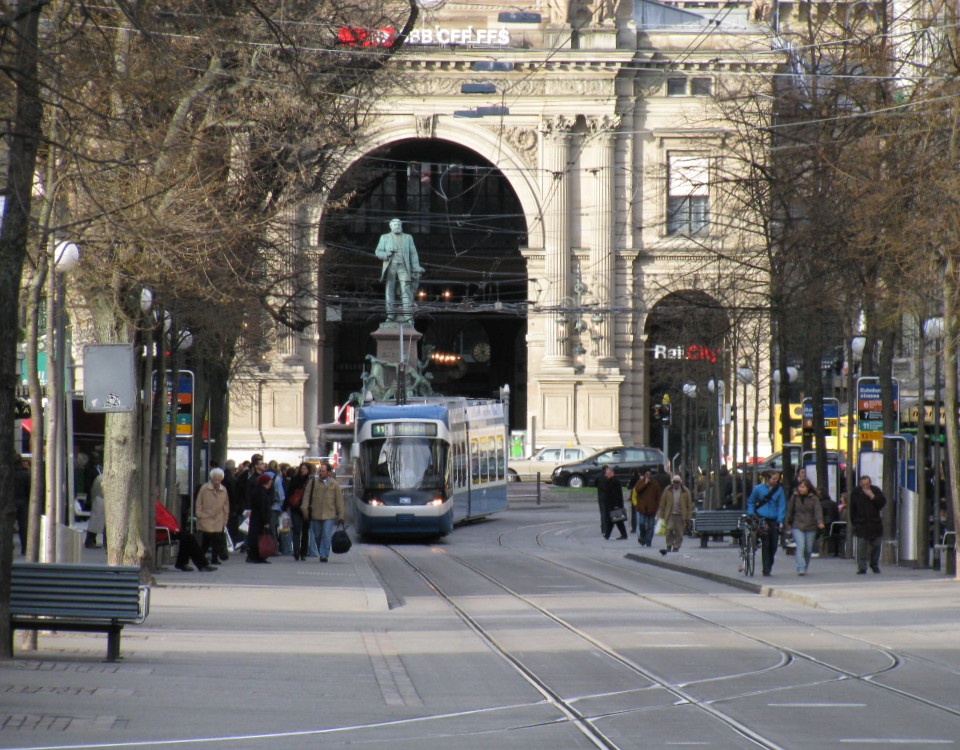 Here is the same scene today. The trees look almost unchanged, but have probably been re-planted many times.
Here is the same scene today. The trees look almost unchanged, but have probably been re-planted many times.
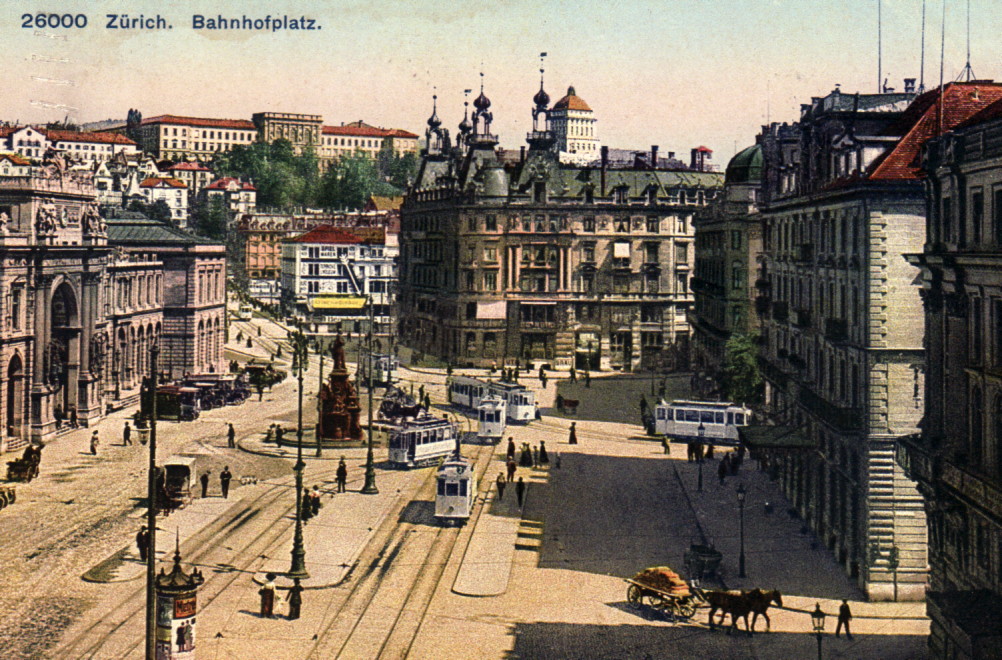 We have just popped around the corner and this is Bahnhofplatz. The statue of Alfred Escher and the station arch are the same as in the previous picture. This postcard is postmarked 1918 but is probably a bit older as the trams still use trolleypoles (these vanished around 1916). On the hill in the background is the ETH (technical university), as yet without its large dome. Although this feature is today an integral part of Zürich's skyline, few people realise that the architect, Gottfried Semper, designed the building without and strongly objected to such a feature. The station building was built by one of his pupils, Jakob Friedrich Wanner. Without the traffic and the tramstop shelters, this area looks much less cluttered than it does today. When will a courageous archtect suggest clearing it all away to restore the dignity of these buildings, most of which still stand today?
We have just popped around the corner and this is Bahnhofplatz. The statue of Alfred Escher and the station arch are the same as in the previous picture. This postcard is postmarked 1918 but is probably a bit older as the trams still use trolleypoles (these vanished around 1916). On the hill in the background is the ETH (technical university), as yet without its large dome. Although this feature is today an integral part of Zürich's skyline, few people realise that the architect, Gottfried Semper, designed the building without and strongly objected to such a feature. The station building was built by one of his pupils, Jakob Friedrich Wanner. Without the traffic and the tramstop shelters, this area looks much less cluttered than it does today. When will a courageous archtect suggest clearing it all away to restore the dignity of these buildings, most of which still stand today?
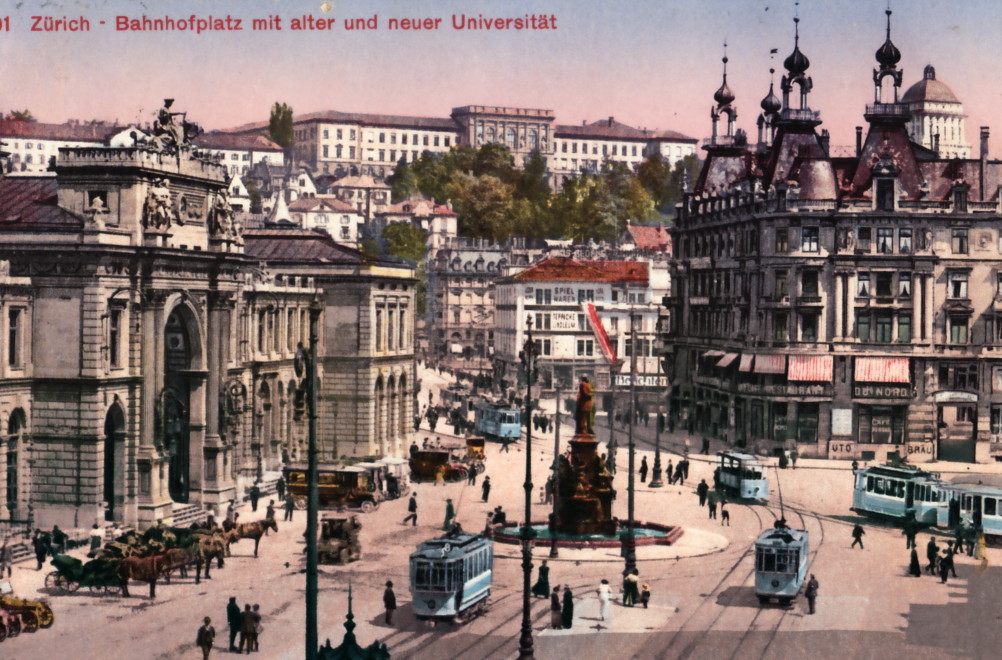 Comparing this scene to the previous, it is difficult to tell whether minutes or years have passed between these two photgraphs. Then, as today, the constant stream of trams is a feature that gives this place a seemingly unchanging face. In fact the upper picture was published by Wehrli of Kilchberg and the lower by their Zürich rival, Photoglob. The lower is postmarked 1916.
Comparing this scene to the previous, it is difficult to tell whether minutes or years have passed between these two photgraphs. Then, as today, the constant stream of trams is a feature that gives this place a seemingly unchanging face. In fact the upper picture was published by Wehrli of Kilchberg and the lower by their Zürich rival, Photoglob. The lower is postmarked 1916.
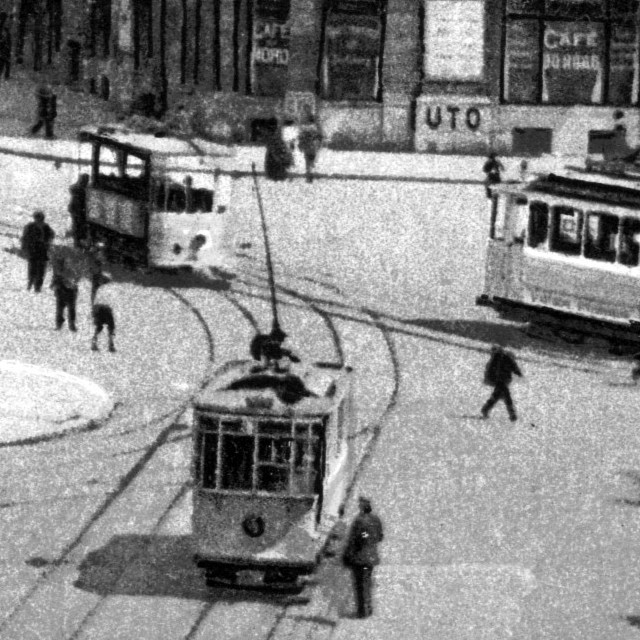 Taking a closer look at the latter view, we see that one of the trams is a works tram (upper left of this enlargement).
Taking a closer look at the latter view, we see that one of the trams is a works tram (upper left of this enlargement).
In those days the scope of duties of works trams was far broader than it is today, and sightings of them would have been less of a rarity. Even so, this vehicle appears to be attracting some interest from bystanders. Possibly this vehicle is Xe2/2 911 or 912. The truck of one of these vehicles was salvaged and is now in use under museum tram (ZOS) 1, of which more later.
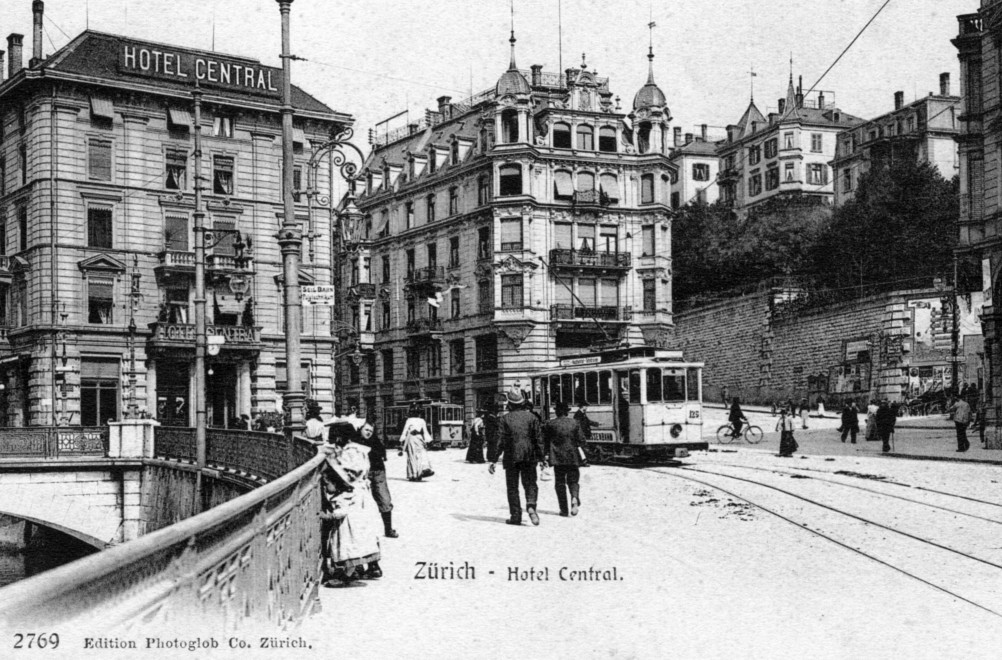 Just across the river (the location is just about visible in the previous views) we reach the tram junction today known as Central. It just shows how much trams define people's awareness that, although the tram stop has long been called Central, the location was called Leonhardplatz. Only relatively recently was it renamed to conform to the usage and cut down on misunderstandings. The tram stop was originally named Central after to the Hotel Central, which still survives today — although most people probably imagine the hotel is named after the location rather than vice-versa (the hotel has a pleasant piano bar by the way).
Just across the river (the location is just about visible in the previous views) we reach the tram junction today known as Central. It just shows how much trams define people's awareness that, although the tram stop has long been called Central, the location was called Leonhardplatz. Only relatively recently was it renamed to conform to the usage and cut down on misunderstandings. The tram stop was originally named Central after to the Hotel Central, which still survives today — although most people probably imagine the hotel is named after the location rather than vice-versa (the hotel has a pleasant piano bar by the way).
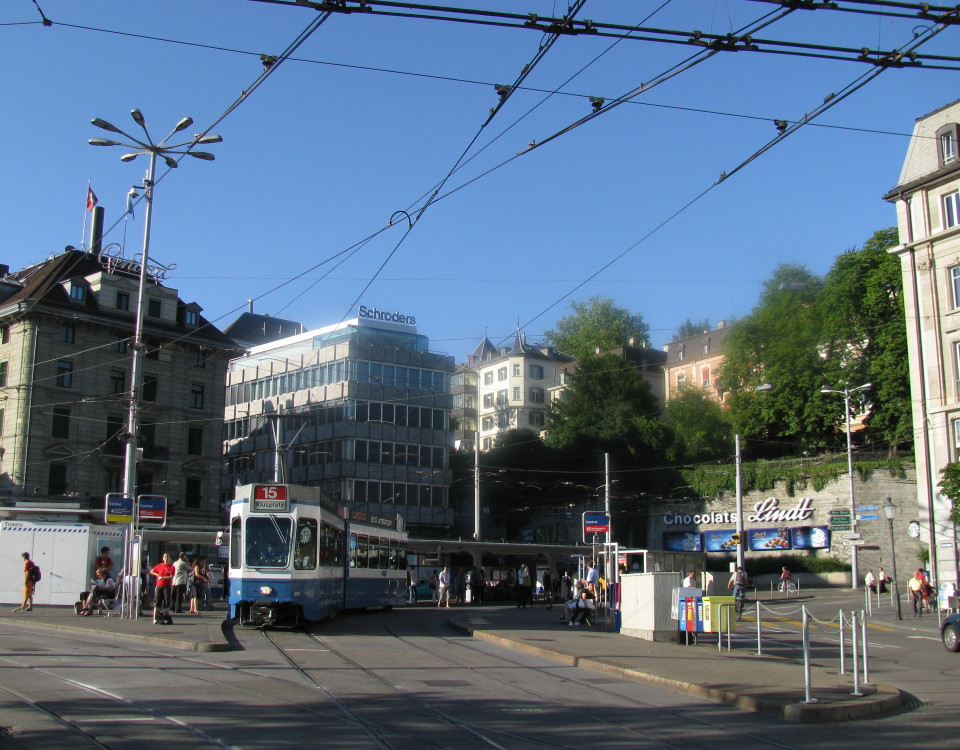 Here is the same scene today. Central is still a busy tram junction, and the hotel Central is still there, as are the villas up on the hill. The ornate building between them has been replaced by something much more boring though (functional is maybe the word?). The building that was just visible on the right was demolished in the 1950s to allow more space for traffic.
Here is the same scene today. Central is still a busy tram junction, and the hotel Central is still there, as are the villas up on the hill. The ornate building between them has been replaced by something much more boring though (functional is maybe the word?). The building that was just visible on the right was demolished in the 1950s to allow more space for traffic.
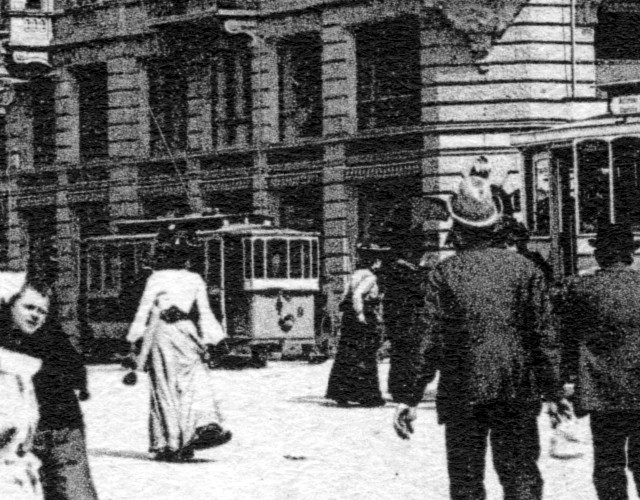 But let's take a closer look at the old view. Just to the left of the tram, we see another tram. This is standing in a side street that today does not have tram tracks. The tram is number 9 of the then still private ZOS company (Zürich-Oerlikon-Seebach). This tram's sister unit, number 1, survives as a museum car proudly sporting the two-tone green livery of its original owners. This narrow street was the city terminus of this company, which failed to obtain running rights over the city tram tracks. The main line of the ZOS company is today tram route 14. Rather than running to Central, however, this now crosses the Limmat river at Stampfenbachbrücke. ZOS also operated branches to Schwamendingen and Glattbrugg. These were closed in the 1930s, but both places have interestigly since regained tram connections, albeit using different alignments.
But let's take a closer look at the old view. Just to the left of the tram, we see another tram. This is standing in a side street that today does not have tram tracks. The tram is number 9 of the then still private ZOS company (Zürich-Oerlikon-Seebach). This tram's sister unit, number 1, survives as a museum car proudly sporting the two-tone green livery of its original owners. This narrow street was the city terminus of this company, which failed to obtain running rights over the city tram tracks. The main line of the ZOS company is today tram route 14. Rather than running to Central, however, this now crosses the Limmat river at Stampfenbachbrücke. ZOS also operated branches to Schwamendingen and Glattbrugg. These were closed in the 1930s, but both places have interestigly since regained tram connections, albeit using different alignments.
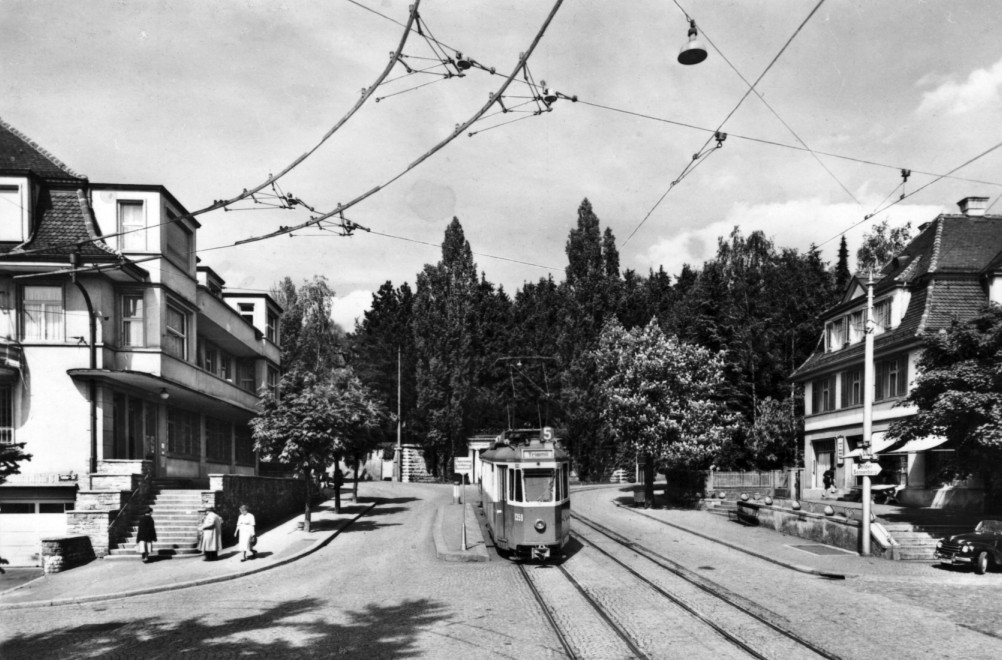 The next view is of somewhat younger vintage. The probably 1950s view shows a scene that is easily recogisable today The trolleybus still turns the corner here, the trees in the background are still there as is the building on the left.
The next view is of somewhat younger vintage. The probably 1950s view shows a scene that is easily recogisable today The trolleybus still turns the corner here, the trees in the background are still there as is the building on the left.
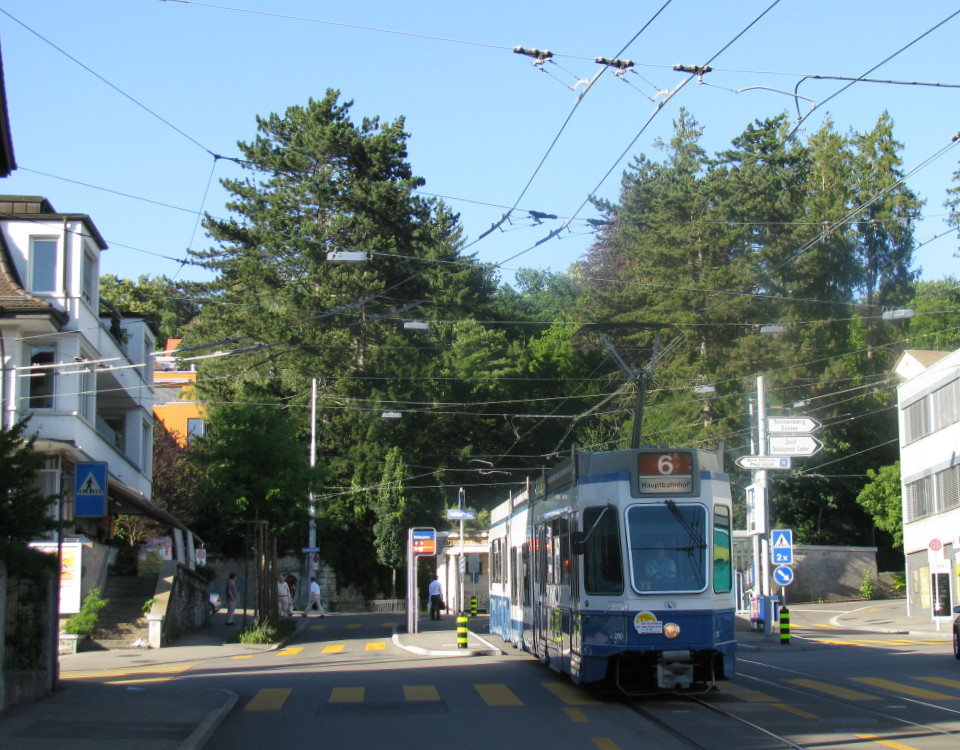 The building on the left is now a Migros supermarket. That on the right has vanished.
The building on the left is now a Migros supermarket. That on the right has vanished.
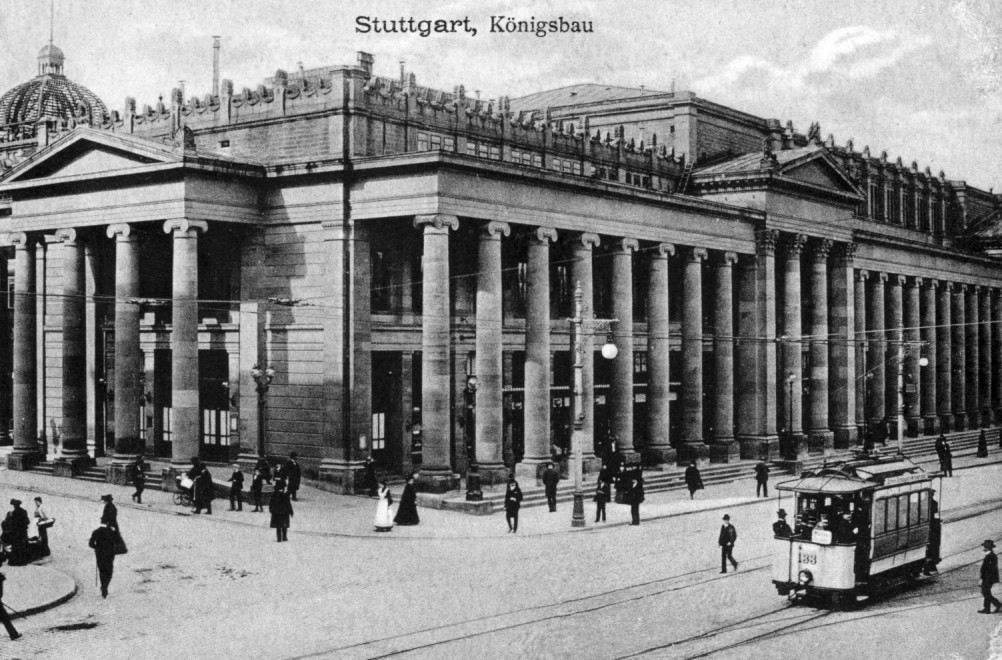 As I don't always and only talk about Zürich, I will in the last section of this presentation present some scenes from elsewhere. This is the Königsbau in Stuttgart. Trams have long ceased to run on the surface here, and the open balcony trams have vanished even longer ago. The building is still there though, and now hosts a shopping centre and the Stuttgart stock exchange.
As I don't always and only talk about Zürich, I will in the last section of this presentation present some scenes from elsewhere. This is the Königsbau in Stuttgart. Trams have long ceased to run on the surface here, and the open balcony trams have vanished even longer ago. The building is still there though, and now hosts a shopping centre and the Stuttgart stock exchange.
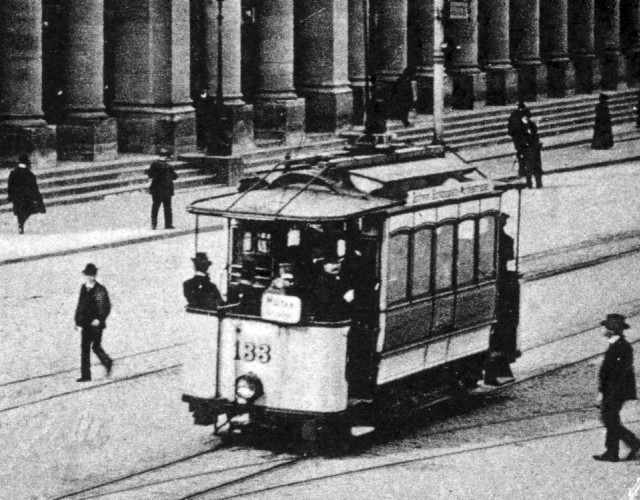 Here is a close-up of that tram. It is a tribute to the printing techniques of these old postcards that you can still get this level of detail at such a magnification.
Here is a close-up of that tram. It is a tribute to the printing techniques of these old postcards that you can still get this level of detail at such a magnification.
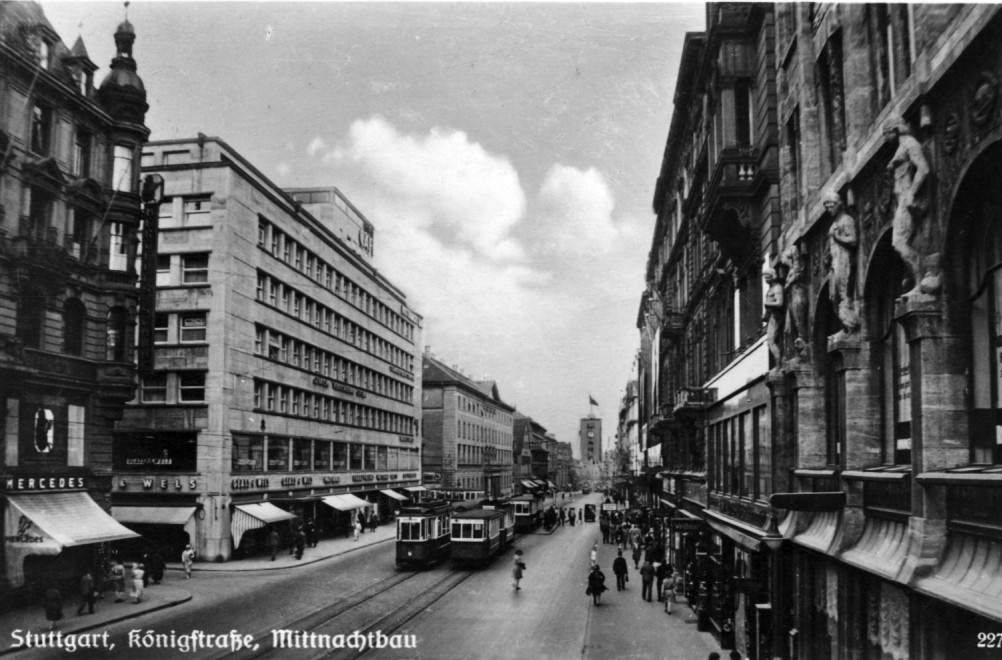 This view was taken little further down that street from the same location. The card is newer (postmarked 1936). The tower of Hauptbahnhof is visible in the background. Trams have since vanished from this location and the street has become an attractive shopping venue.
This view was taken little further down that street from the same location. The card is newer (postmarked 1936). The tower of Hauptbahnhof is visible in the background. Trams have since vanished from this location and the street has become an attractive shopping venue.
view photos
Zürich tram history pages
Zürich tram newslog
Zürich tram main page
This page added: July 2008
